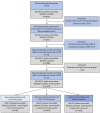The Bigger the Better? Center Volume Dependent Effects on Procedural and Functional Outcome in Established Endovascular Stroke Centers
- PMID: 35309589
- PMCID: PMC8925986
- DOI: 10.3389/fneur.2022.828528
The Bigger the Better? Center Volume Dependent Effects on Procedural and Functional Outcome in Established Endovascular Stroke Centers
Abstract
Background: Mechanical thrombectomy (MT) rates for the treatment of acute ischaemic stroke due to large vessel occlusion are steadily increasing, but are delivered in heterogenic settings. We aim to investigate effects of procedural load in centers with established MT-structures by comparing high- vs. low-volume centers with regard to procedural characteristics and functional outcomes.
Methods: Data from 5,379 patients enrolled in the German Stroke Registry Endovascular Treatment (GSR-ET) between June 2015 and December 2019 were compared between three groups: high volume: ≥180 MTs/year, 2,342 patients; medium volume: 135-179 MTs/year, 2,202 patients; low volume: <135 MTs/year, 835 patients. Univariate analysis and multiple linear and logistic regression analyses were performed to identify differences between high- and low-volume centers.
Results: We identified high- vs. low-volume centers to be an independent predictor of shorter intra-hospital (admission to groin puncture: 60 vs. 82 min, β = -26.458; p < 0.001) and procedural times (groin puncture to flow restoration: 36 vs. 46.5 min; β = -12.452; p < 0.001) after adjusting for clinically relevant factors. Moreover, high-volume centers predicted a shorter duration of hospital stay (8 vs. 9 days; β = -2.901; p < 0.001) and favorable medical facility at discharge [transfer to neurorehabilitation facility/home vs. hospital/nursing home/in-house fatality, odds ratio (OR) 1.340, p = 0.002]. Differences for functional outcome at 90-day follow-up were observed only on univariate level in the subgroup of primarily to MT center admitted patients (mRS 0-2 38.5 vs. 32.8%, p = 0.028), but did not persist in multivariate analyses.
Conclusion: Differences in efficiency measured by procedural times call for analysis and optimization of in-house procedural workflows at regularly used but comparatively low procedural volume MT centers.
Keywords: GSR-ET; center volume; endovascular stroke therapy; mechanical thrombectomy; procedural volume; stroke.
Copyright © 2022 Hahn, Gröschel, Tanyildizi, Brockmann, Gröschel, Uphaus and German Stroke Registry-Endovascular Treatment (GSR-ET) Investigators.
Conflict of interest statement
TU reports personal fees from Merck Serono and Pfizer, grants from Else Kröner-Fresenius Stiftung. KG reports personal fees and/or non-financial support from Bayer, Boehringer Ingelheim, Bristol-Meyers Squibb, Daiichi Sankyo, and Pfizer. MH reports personal fees from Bristol-Meyers Squibb, outside of the submitted work. The remaining authors declare that the research was conducted in the absence of any commercial or financial relationships that could be construed as a potential conflict of interest.
Figures



References
-
- Krogias C, Weber R, Richter D, Bartig D, Eyding J. Bundesweite Versorgungsrealität von Patienten mit akutem Hirninfarkt in Deutschland: update der regionalisierten Analyse zur Anwendung rekanalisierender Therapieverfahren und einer Schlaganfallkomplexbehandlung. Nervenarzt. (2020) 91:908–19. 10.1007/s00115-020-00983-0 - DOI - PubMed
LinkOut - more resources
Full Text Sources
Miscellaneous

